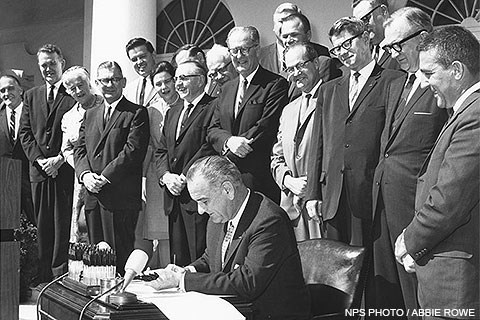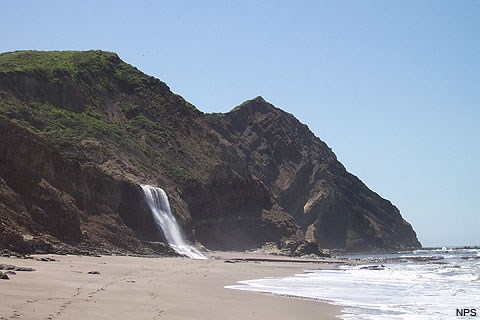
The U.S. Congress passed and President Lyndon Baines Johnson signed the Wilderness Act on September 3, 1964, to provide the highest level of protection for some of America's iconic, wild landscapes. Twelve years later, in 1976, the U.S. Congress passed legislation (Public Law 94-544), which President Ford signed, creating the Point Reyes Wilderness. In 1985, the US Congress passed Public Law 99-68, which, with President Reagan's signature, renamed the designated Wilderness area of Point Reyes National Seashore as the "Phillip Burton Wilderness." Wilderness areas are public lands. This means Wilderness belongs to everyone. Wilderness areas provide intact habitat for wildlife, clean drinking water for cities, recreational opportunities for outdoor enthusiasts, sources of inspiration for artists, and much more. In 2014, the NPS invited the public to join in recognizing the 50th anniversary of the Wilderness Act by reflecting on what Wlderness means to you—is it a place of inspiration? Adventure? Or maybe even a place you have not visited but still appreciate? The National Park Service manages 50 parks with designated Wilderness that provide opportunities for solitude and primitive recreation, enjoyment of the natural night sky, and spiritual replenishment. These areas are diverse and include forested mountains, deserts, alpine meadows, tundra, lava beds, coasts, and even swamps. Over 40 million acres of lands are designated as Wilderness across the national parks system because they have outstanding opportunities for solitude that people enjoy through recreational, scenic, scientific, educational, conservation, and historical use. 
Wilderness at Point ReyesPoint Reyes National Seashore is home to the Phillip Burton Wilderness Area, where visitors can explore over 30,000 acres of forested ridges, coastal grasslands, sand dunes, and rugged shoreline. Visitors can enjoy a quiet evening on a secluded beach watching the sun set over the Pacific Ocean, or experience the power of a winter storm or the spring winds generating massive waves on the Point Reyes Beach. Over 100 miles of trails wind their way through the park's Wilderness, inviting visitors to leave the stress of today's mechanical/electronic world behind for an hour or a day. Wildlife also thrives throughout the park's Wilderness. Visitors may observe tule elk on Tomales Point, harbor seals, waterfowl, and shorebirds in the Estero de Limantour, and a multitude of marine invertebrates in tidepools. All of this within a couple-hours travel time for over eight million San Francisco Bay area residents. Wilderness FAQsDesignated Wilderness is the highest level of conservation protection for federal lands. Only Congress may designate Wilderness or change the status of Wilderness areas. Wilderness areas are designated within existing federal public land. Congress has directed four federal land management agencies—the National Park Service, the Bureau of Land Management, the U.S. Fish and Wildlife Service, and the U.S. Forest Service—to manage Wilderness areas so as to preserve and, where possible, to restore their wilderness character. The wild, undeveloped areas of national parks (often called "backcountry") are subject to development, road building, and off-road mechanized vehicular use. National park backcountry is protected only by administrative regulations that agency officials can change. The Wilderness Act protects designated wilderness areas by law "for the permanent good of the whole people." With the Wilderness Act, Congress secures "for the American people of present and future generations the benefits of an enduring resource of wilderness." Through the Wilderness Act, Congress recognized the intrinsic value of wild lands. Some of the tangible and intangible values mentioned in the Wilderness Act include "solitude or a primitive and unconfined type of recreation," as well as "ecological, geological, or other features of scientific, educational, scenic, or historical value." Wilderness areas provide habitat for wildlife and plants, including endangered and threatened species. Wilderness protects open space, watersheds, natural soundscapes, diverse ecosystems, and biodiversity. The literature of wilderness experience frequently cites the inspirational and spiritual values of wilderness, including opportunities to reflect on the community of life and the human place on Earth. Wilderness provides a sense of wildness, which can be valuable to people whether or not those individuals actually visit wilderness. Just knowing that Wilderness exists can produce a sense of curiosity, inspiration, renewal, and hope. Wilderness areas are places where humility and respect play a role in both individual and management activities. People can recreate in Wilderness, though in most places individuals do so without mechanical transport. Visitors may hike, fish, camp, watch wildlife, photograph, or hunt (where legally authorized). Most park visitors will probably never enter into a Wilderness area, yet they enjoy Wilderness as a scenic backdrop to developed park areas. Videos from NPSWilderness
Visit our keyboard shortcuts docs for details
See the natural rhythms of Point Reyes National Seashore's Phillip Burton Wilderness. Point Reyes is the windiest place on the Pacific Coast, one of the foggiest places in North America, and home to thirty-eight threatened or endangered species.
Visit our keyboard shortcuts docs for details
Point Reyes National Seashore, located just an hour north of San Francisco, is home to the Phillip Burton Wilderness. This wilderness area protects more than 26,000 acres of important habitat and serves as a place of inspiration for people near and far.
Visit our keyboard shortcuts docs for details
Join local photographers Kathleen Goodwin and Richard Blair on Kehoe Beach in the Phillip Burton Wilderness. Point Reyes National Seashore includes 80 miles of coastline, most of which is designated wilderness.
Visit our keyboard shortcuts docs for details
The Wilderness Act of 1964 established the National Wilderness Preservation System, a national network of more than 800 federally-designated wilderness areas. These wilderness areas are managed by the National Park Service, Bureau of Land Management, US Fish and Wildlife Service, and US Forest Service. |
Last updated: November 29, 2025
